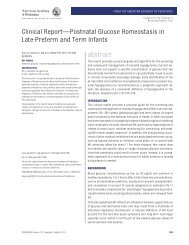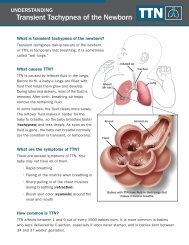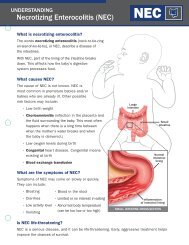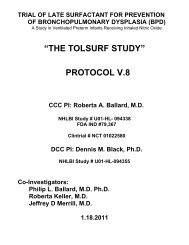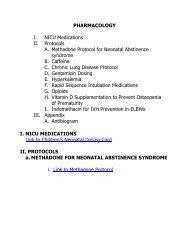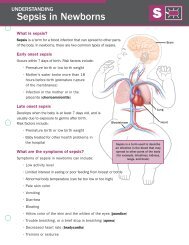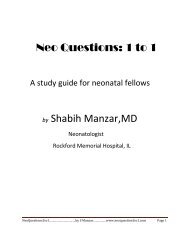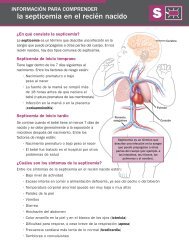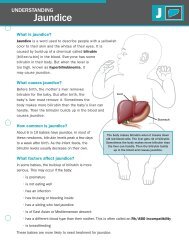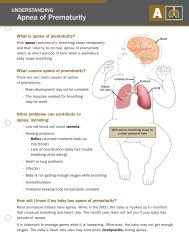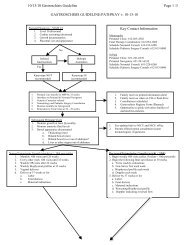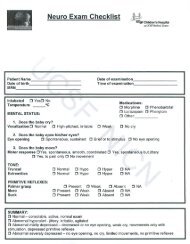Neonatal Presentations of CHARGE Syndrome and VATER
Neonatal Presentations of CHARGE Syndrome and VATER
Neonatal Presentations of CHARGE Syndrome and VATER
- No tags were found...
Create successful ePaper yourself
Turn your PDF publications into a flip-book with our unique Google optimized e-Paper software.
genetics<strong>CHARGE</strong> <strong>and</strong> <strong>VATER</strong>/VACTERLangular concha (Fig. 2). Middle ear anomalies includeossicular malformations, an abnormal or absent ovalwindow, <strong>and</strong> absent stapedius muscle. Among the innerear anomalies are aplastic or hypoplastic semicircularcanals, <strong>and</strong> the Mondini defect (decreased number <strong>of</strong>turns to the cochlea) is present in up to 95% <strong>of</strong> affectedindividuals <strong>and</strong> can be detected by CT scan <strong>of</strong> the temporalbones. Temporal bone abnormalities also may bepresent. The combination <strong>of</strong> ossicular malformations <strong>and</strong>inner ear defects frequently results in a mixed (conductive<strong>and</strong> sensorineural) hearing loss that can range frommild to pr<strong>of</strong>ound.Although not described in the original acronym, cranialnerve (CN) anomalies also are common <strong>and</strong> now areincluded among the major diagnostic criteria (Table).Such anomalies usually are asymmetric <strong>and</strong> can involveCN I, resulting in hyposmia or anosmia (an absentor hypoplastic olfactory bulb is highly indicative <strong>of</strong><strong>CHARGE</strong>); CN V, resulting in the incoordination <strong>of</strong>sucking, chewing, <strong>and</strong> swallowing; CN VII, resulting infacial paralysis that is usually unilateral (Fig. 3); CN VIII,resulting in sensorineural hearing loss; <strong>and</strong> CN IX/X/XI, resulting in dysfunctional swallowing, gastroesophagealreflux, <strong>and</strong> velopharyngeal aspiration.A clinical diagnosis <strong>of</strong> <strong>CHARGE</strong> syndrome can bemade based on the major <strong>and</strong> minor diagnostic criteria(Table) defined by Blake <strong>and</strong> associates in 1998. Thepresence <strong>of</strong> all four major criteria (choanal atresia,coloboma, characteristic ears, <strong>and</strong> cranial nerve anomalies)or three major <strong>and</strong> three minor characteristics indicatesa diagnosis <strong>of</strong> <strong>CHARGE</strong> syndrome. The diagnosisshould be considered strongly in any neonate who exhibitsone <strong>of</strong> the major diagnostic criteria, <strong>and</strong> evaluation forabnormalities in other organ systems involved in<strong>CHARGE</strong> should be initiated.Figure 2. Hypoplastic lobule, prominent antihelix, <strong>and</strong> trangularconcha characteristic <strong>of</strong> the typical “<strong>CHARGE</strong> ear.”Genetic TestingIn 2004, Vissers <strong>and</strong> colleagues identified a molecularcause for <strong>CHARGE</strong> syndrome. The responsible gene isCHD7 (chromodomain helicase DNA-binding protein7); the encoded protein regulates gene expression byaltering chromatin structure <strong>and</strong> plays a critical role inembryogenesis. Clinical testing is currently available, <strong>and</strong>the mutation detection frequency is approximately 60%to 65%.Despite the availability <strong>of</strong> mutation analysis,<strong>CHARGE</strong> syndrome remains a clinical diagnosis. In theneonatal period, the presence <strong>of</strong> iris or retinal coloboma,choanal atresia, characteristic ears, hearing loss, facialnerve palsy, or congenital heart defects should alert thephysician to the possible diagnosis. The evaluations initiatedin the neonatal intensive care unit should includean ophthalmology examination, echocardiography, earnose-throatevaluation, renal ultrasonography, <strong>and</strong> hearingscreen. The most sensitive diagnostic study, whichhas implications for management, is a CT scan <strong>of</strong> thetemporal bones. Approximately 95% <strong>of</strong> affected patientshave abnormalities <strong>of</strong> the inner <strong>and</strong> middle ear, includingthe Mondini defect, aplasia or hypoplasia <strong>of</strong> the semicircularcanals, <strong>and</strong> ossicular malformations. A highresolutionkaryotype should be performed to rule out achromosomal abnormality as the cause <strong>of</strong> multiple malformations.CHD7 analysis may be helpful in cases wherethe diagnosis is not clear, especially if the family is interestedin prenatal diagnosis for future pregnancies. Insimplex cases, the recurrence risk for the parents is low,but prenatal testing can be <strong>of</strong>fered to the family if there isa known mutation to rule out the unlikely event <strong>of</strong>germline mosaicism. The individual who has <strong>CHARGE</strong>syndrome has a 50% risk <strong>of</strong> having an affected child witheach pregnancy.<strong>VATER</strong>/VACTERL AssociationIn contrast to <strong>CHARGE</strong> syndrome, <strong>VATER</strong> (orVACTERL) association does not have a known molecularcause. <strong>VATER</strong> association initially was described byQuan <strong>and</strong> Smith in 1973, <strong>and</strong> the acronym describes thecomponents: Vertebral defects, Anal atresia, Tracheo-Esophageal fistula with esophageal atresia, <strong>and</strong> Radial<strong>and</strong> Renal dysplasia. Kaufman (1973) <strong>and</strong> Nora <strong>and</strong>Nora (1975) subsequently added “C” for cardiac defects<strong>and</strong> “L” for limb defects to broaden the acronym toVACTERL.NeoReviews Vol.9 No.7 July 2008 e301Downloaded from http://neoreviews.aappublications.org by J Michael Coleman on August 12, 2010



